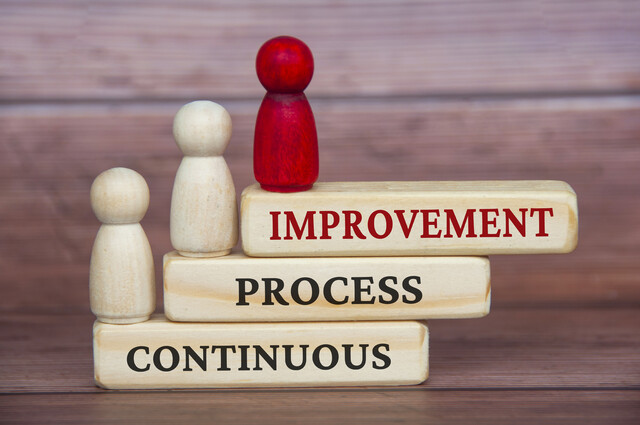Effective meetings have strong leadership from both management and the chair of the meetings to direct and guide everyone as efficiently as possible. Leaders accomplish this by establishing a strong rapport and respect from all of the participants of the meeting. A great leader can "rally the troops" and get a meeting moving quickly and effortlessly. Members of the team appreciate a strong leader who can keep disruptions and distractions to a minimum and finish as quickly as possible. No team member or leader wants to attend meetings all day so getting through effectively and quickly is the ultimate goal.
"Winning is Everything"
Derrick loves to argue. In his mind, he is right and he will prove it. In life, it is always a debate with him, and he enjoys getting the most out of it. Winning is everything. He always has a chip on his shoulder that made him a shrewd business person and star in the finance department.
A new meeting invitation goes out to several of the team members in the finance department, hosted by a group of managers and engineers. The goal of the meeting is to understand how to integrate a merger with a small accounting company. The company had specialty software that increased the efficiency of the department. Derrick's company wanted that advantage.
Derrick and his colleague, Ryan, decided to attend this meeting. There were several high-level managers and IT software members attending. The meeting kicked off and the topic is the software package's ability to do certain finance functions. Immediately, Derrick recognized a small compatibility problem and interrupted the chair to point out the flaw. The chair made a note and moved on with the presentation of the company.
Next, the company went on to talk about rolling this out to the IT systems. Derrick quickly interrupted the meeting and told the IT team that this will be a compatibility problem with their servers. The chair looked annoyed. "The systems will be revamped once the merger happens." Derrick shot back in an argumentative point, "The systems were just replaced last year, which will cost millions." One of the executive managers got up and motioned Derrick outside of the room. "Derrick, we are aware of these issues; this has been a project to use their IT capability. You missed the previous meetings and you are not in the loop. Why don't you go back to your desk? We have it handled here."
Perplexed, Derrick returned to his cube. Two hours later, Ryan returns and sits down at his desk. Derrick turns to Ryan. "So, how was this meeting? Everything seems so screwed up. Why won't anyone listen to me?"
Ryan shrugs his shoulders and twirls around in his chair. Right then, an email announces Ryan's promotion. His task is to manage the team to integrate the finance department. Derrick was frustrated and angry. He wondered why he did not get the promotion opportunity. He knows everything about the systems. Why Ryan?
3.1 Running the Meeting
Before the first person steps foot into the conference room, the chair prepares the room. The computer or projector screens are on, chairs positioned, agenda or presentations are ready to distribute. Always arrive five to 10 minutes early to prepare the conference room.
Greet each team member when he or she enters the room. This gives them a warm reception and helps them feel like they belong to this group.
Always start the meeting on time, every time. Being late to start reflects poorly on the leadership and management of the chair.
When a meeting is ready to start, the chair of the meeting will get everyone's attention. They generally will speak up and tell the room the meeting is going to start.
Start the meeting with a good message or joke. A positive message or a sincere, "Thank You for Coming," does show you appreciate the team's attendance.
In larger meetings or breakout sessions, using an icebreaker is a good technique to get the audience engaged early and relieve tension in the room. An icebreaker is a game or exercise that engages the audience, like having a company trivia game.
When there are new members, or clients in the meeting, you will want to have everyone in the room introduce him or herself. This helps identify team members and their job responsibility in the business, but also introduces the leadership positions of the meeting.
Establish the ground rules for the meeting. This is important, because it determines how the meeting will run. A general set of rules to consider, suggested by Barbara Streibel in The Manager's Guide to Effective Meetings, is:
- Attendance
- Promptness and penalty for late members
- Participation in the meeting
- Meeting role assignments
- Interruptions: Cell phones off, or on vibrate
- Respect everyone
- The discussion process and decision-making
- Confidentiality: Determine what information does not leave the room.
- Assignments given out
- Method for evaluating meetings
- Chronic violation of the rules
Start and follow the agenda items. Ask each person assigned a task to present new information. Remind each presenter the amount of time allocated in the agenda for them to deliver their report.
During the meeting, do not quickly jump to conclusions in the middle of the presentation. Determine if all the information is strong enough to make a decision, or not enough to move forward. Weigh in on the amount of risk you are willing to take, versus how much information you actually have. Get feedback from the team members who might have a great background or experience in the topic.
Close out each agenda item. Make sure the note-taker is updating the agenda, and adding information for the next meeting. When a team member takes on an assignment, the note-taker must update the agenda with that person as responsible.
If an agenda item exceeds the allocated time, determine if it needs wrapping up, or should be delayed to next week. When the time runs out, politely remind the presenter we have to conclude this topic.
At the end of the meeting time, or when you reach the bottom of the agenda, you can open the floor up for a roundtable discussion. The roundtable is time allocated at the end of the meeting for the team to bring up new topics or action items that need attention. Go around the room with everyone and ask if they have anything for roundtable. Limit the time to a few minutes for each person, so you will not overrun the meeting.
3.2 Do's and Don'ts of an Effective Meeting
Effective meetings take a bit of experience and practice. Management of people can be very difficult; great leaders hone their soft skills to move the team forward as a collective unit. They earn the respect of their team members and peers with a consistent professional approach to all situations.
During meetings, good leaders follow the do's and don'ts as highly skilled managers. These are suggested rules to follow while running or participating in meetings. Even if you have not accumulated the experience and skill set, these rules help you project yourself as a professional in the business while running the meeting.
DO
- Start and end on time.
- Have a set of tasks or decisions on the agenda. Never just "wing it."
- Stick with the time on the agenda; do not overrun, if possible.
- Give clear direction on task items, and ask to repeat it back from the individuals if there is confusion.
- Be direct and ask questions when necessary.
- Do not cut people off, unless time is a factor.
- Avoid jumping from one agenda item to another too quickly.
- Do not jump to conclusions too quickly.
- Always ask for opinions � try to coax them from others who do not normally speak out. Ask for feedback on a decision.
- If too many people talking at the same time, ask for the floor and direct conversation, one at a time.
- Be late all the time.
- Allow meetings to run over the ending time.
- Show favoritism in the meeting to individuals.
- Lack attention or energy in the meeting.
- Try to talk over someone else. Let each person speak and make his or her statement.
- Allow multiple conversations over the topic. This makes too many people debating and talking at the same time.
- Never get emotionally involved as the chair; just stay the course that needs to be completed.
- Do not ever assign tasks as punishment for breaking rules; this gives a negative feeling toward the project or meeting.
- Do not ever pile up too many rules for the meeting; it makes it harder for people to remember them.
Dealing With Common Meeting Problems
In every company or business, many different personalities have to work together. Great managers and leaders know how to handle these when overseeing a group trying to accomplish something. Managing the personalities takes development of strong people skills. Leaders joke that solving the business problems is the easy part; dealing with individuals is much harder.
No doubt, there will be times where difficulties happen during the meeting. The best way to handle it is see the problem coming, and find ways to prevent it from happening.
"Marketing Herds"
Jill was relatively new to the company. She joined the company recently and was on her way up the corporate ladder. She had proven herself as a talent by taking on a few big projects, and helped complete them on time successfully. She was always thinking up the next big idea, and one day it came to her.
She thought of a new marketing idea that could breathe new life into their product. The idea was very quirky, intelligent, and added a twist to the advertising campaign. She wrote down the details and what she thought would be a mini storyboard campaign. She had taken marketing in college, and remembered the steps to getting her idea on paper. Jill soon had something in succession that could tell the story and make a great idea stand out to the customer. The whole idea was brilliant!
She presented the idea to her core managers and really pushed herself to lead this idea. The managers agreed that she could take on this project and instructed her to present it to marketing. The goal was to bring on the core marketing team and give her the opportunity to develop the concept.
Jill scheduled a meeting later that week with the core marketing team. She went into the presentation of her new idea. On the first board, she presented the introduction to her idea. One of the marketing team members quickly stopped Jill, and he suggested changing the character to a more cartoonish type. Then the assistant marketing chief mentioned the character should be more in line with a different product.
The conversation went on about a cartoon character for another 15 minutes. Then the marketing team came back to look at the next slide. They quickly spun this off into several ideas about a cheesecake and a Corvette.
After the meeting was over, Jill returned to her core managers to update her progress. The block of time came for her presentation. "How was your presentation to marketing Jill?" the team leader asked.
Jill paused for a moment."It's like herding cats up there."
A great laughter erupted from everyone in the room.
"Yes, you do have quite a bit of Type A personalities in marketing," the leader explained.
"Next time, let's set the ground rules with them about going off on a different direction, and let them hear you out."
4.1 Too Formal or Informal of a Meeting
Too formal or informal of a meeting causes members a hard time to adjust. They simply do not know how to respond or provide the information available.
Members feel out of place when a meeting becomes too formal. Having a low-level employee meeting with executives can place a high amount of stress and uncertainty on them.
When it's too informal of a meeting, the members tend to relax too much and not obey the ground rules set. This looks poor to the team leader or chair to allow a loose informal meeting on a business topic.
Participation in the meeting might suffer if the meeting is too formal.
4.2 Lack of Planning and Detail
Lack of detail can lead to mistakes and oversights on a project. "The devil is in the details." Missing a key piece of information due to lack of attention to detail can derail an entire project.
When there is a lack of planning, this prolongs confusion in the group. When members do not even know what conference room to attend, due to lack of planning, you can quickly lose attendance and credibility as a leader.
Lack of planning or detail can cause the meeting to lose focus quickly. The team can go down an entire different path, because the constraints are not there to stop it.
Participants keep talking around the issue, and never to the solution or problem. The real issues are not resolved or addressed.
4.3 Late Start / Late Finish
A common problem is getting the room ready for the meeting. The meeting starts late and pushes the whole agenda back.
When this repeats often, it shows poor leadership from both the chair and management.
A late start to the meeting hurts getting all the action items to be resolved. No matter how well you plan, a late start to the meeting ruins the entire agenda. It wastes your time as a leader trying to plan ahead of the meeting.
A late start hurries the timing through the agenda. The meeting might have to end, cutting off part of the agenda. This hurts the quality of the meeting.
Late finishes always push conference room time into the next meeting. This causes the next team needing the conference room to become late. This snowballs through the day, causing inefficiency through the whole business.
4.4 Favoritism Among Leadership
Strong leaders tend to balance participation through the entire team, asking others for their opinion.
Weak leaders tend to choose "their people" and tend to look after them to shine.
Weak leaders believe only "their people" are the ones competent enough, or the only ones they trust to get the job done.
Favoritism from the chair or leader tends to shut out other members' ideas. (Charles River Editors, 2011)
Poor leadership and favoritism causes the team to lose interest in participation. The team finds no value in the meeting to contribute.
4.5 Failure to Listen to Points or Suggestions
A weak chair or leader has a one-track mind; they will not listen to open suggestions.
The weak leader essentially closes out any feedback from the team, and does not want to hear about it.
When the meeting or direction of the project is going down the wrong path, the weak leaders will continue, even against the wishes of the team.
Typically, when a chair has a strong ego and self-worth, they are sensitive to any feedback from their peers. They will not let anyone else be better than them.
A weak leader alienates the team; nobody will want to contribute to the meeting. The team will not add any suggestions or points.
4.6 Infinite Loop Conversations
Infinite loop conversations occur, because of weak agenda topics or a weak chairperson. These are people talking over the same subject repeatedly.
When the team gets off track and discusses items not related to the topic, a strong chair will intervene. A weak chairperson allows members to create infinite loops of conversation over the same topic.
When the meeting has a weak chairperson, the conversations can quickly get off topic. Usually a team member goes off on a tangent about the subject, which leads into another conversation. Good leaders will remind the team about the agenda and refocus. Good leaders will summarize the other topic, and ask the team if this should be an action item for the next meeting.
The subject falls into the "what if" game. This is actually someone being careful not to take risk. However, when you have individuals who start this, the infinite loop creates a "what if" of possibilities. The team falls into this endless loop, unless the chair stops it and focuses on the agenda item.
4.7 Weak Participation
Poor leadership will not enforce company policy or the rules of the meeting. The members do not listen or respect the policy sent out by the team chair or leadership, causing weak participation.
The lack in belief in the project causes weak participation. Team members think the goal of the meeting or project is a dead-end and has no value. It is not worth their time to join in the meeting.
The meeting is not well-organized and members have a difficult time finding the conference rooms. This is due to poor planning on the chair and leadership's behalf.
The meeting start times are in direct conflict with other meetings, or difficult to attend. This happens frequently on global meetings, where several members are not even in the same time zone.
The conference room is too small, hard to find, or in a location that makes it impossible to attend the meeting.
The meeting has no direction; it's stuck in infinite loops, wasting everyone's time. The leader is weak, and cannot direct the meeting through these distractions.
The chair fails to send out the agenda in time, causing members to have difficulty scheduling their time for it.





























